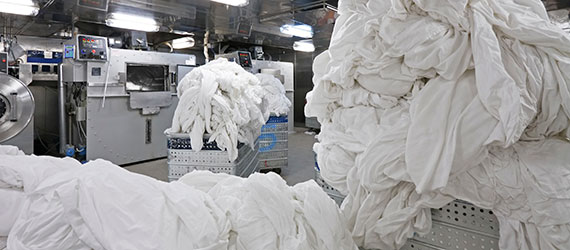Launder at low temperature for sustainability and lower costs
Hospitals, care-homes, hotels and others who run on-premises laundries can dramatically improve sustainability and cut costs by moving to lower wash temperatures. Maintaining top-class performance is vital in such operations, but that’s readily achievable with modern professional laundry products that use a variety of advanced ingredients.

On-premises laundries need to process large volumes of fabrics and garments like bed linen, towels, robes, table cloths, uniforms and workwear. Laundered items must look fresh and clean and feel comfortable because appearance and aesthetics are vital for customer approval and sense of wellbeing. Wash processes should also be as gentle as possible to prolong fabric life, which minimizes the waste and cost of replacement items.
Many laundry applications also need effective disinfection of fabrics to eliminate the risk of transmission of infection. Generally, there’s a duty of care to the customer but in healthcare settings, where patients and users are likely to have reduced immunity, it’s critically important.
There has been some reluctance to move away from high temperatures of 70oC which were seen as the best assurance of effective disinfection, though in fact this depends heavily on maintaining high temperatures for specific periods of time. But this is fast changing as the efficacy of modern products at lower temperatures is increasingly demonstrated through practical experience and quality assurance as well as standard disinfection testing.
Reducing wash temperatures can also substantially reduce cycle times because most on-premises machines heat water internally: the higher the temperature, the longer that takes. Shorter cycles mean greater productivity from the machine and the operators.
Modern laundry products now rely less on traditional bleaches and brighteners, and use clever combinations of advanced actives, including low temperature bleaches and bleach activators, and advanced enzymes.
Two examples illustrate what is now being achieved:
- Hotel laundries are energy hungry, with large quantities of bed-linen, towels and robes to wash, and temperatures of 60oC or over are regularly used. Energy savings of 35 – 45% can potentially be achieved by washing at 40oC rather than 60 oC. This not only saves the fuel used to generate the energy, it eliminates the corresponding release of CO2 to the atmosphere, and of course it cuts costs proportionately.
- One hotel studied found that by re-setting machines to 40oC instead of 60 oC, and choosing products which were kinder to cotton, extending life by up to a third, it was able to reduce its energy use per cycle by almost half. Shorter cycle times also increased overall productivity.
- A care-home laundry had routinely washed fabrics including bed linen and towels at 71oC. Ensuring effective elimination of S. aureus, including MRSA, and C. difficile were critical requirements in this setting. By adjusting machines to 40oC, and using a combination of advanced laundry products which were shown to give effective disinfection at that temperature, performance was fully maintained with no discernible effect on fabric cleanliness or quality. Costs were slashed by a remarkable 65%, with a corresponding environmental benefit from eliminating the fuel use and CO2 release.